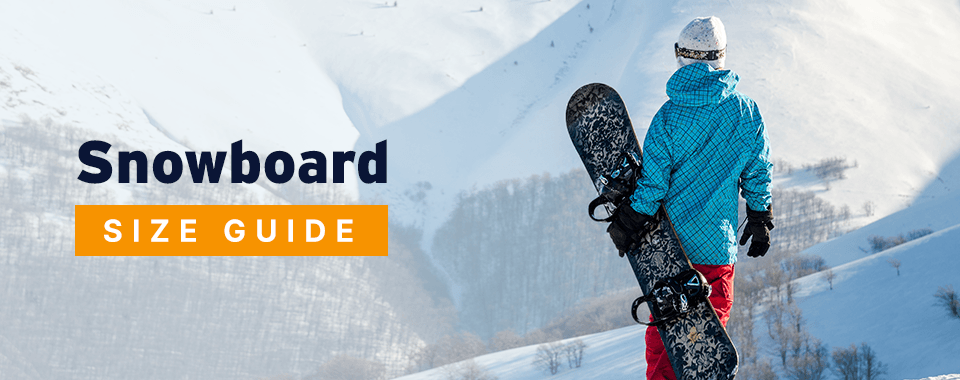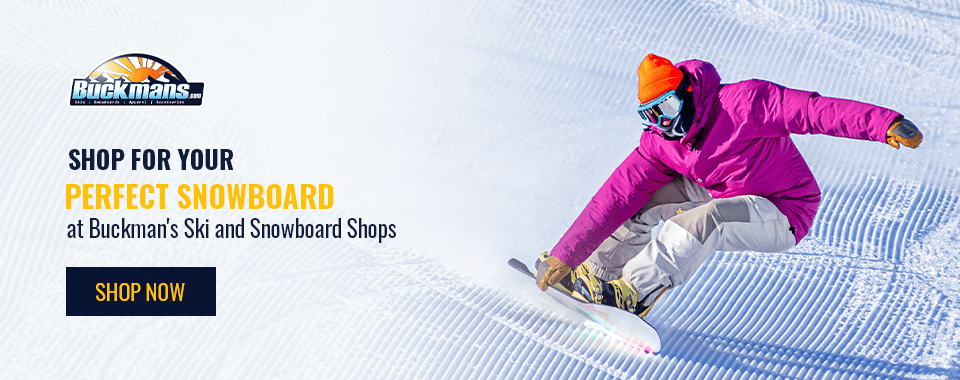 Snowboard Size Guide
Snowboard Size Guide
Snowboard Sizing Guide
Posted
by
Buckman's Ski & Snowboard Shops
on Friday, August 16, 2024
There's nothing quite as exhilarating as snowboarding down a pristine slope and nailing that perfect run. But before you can fully embrace the thrill, you need to find the right board — and that starts with understanding snowboard sizing.
Gone are the days when choosing a board was as simple as picking your favorite color or matching it to your chin height. Today, sizing a snowboard carefully considers multiple critical factors.
How Does Snowboard Sizing Work?
When determining what size snowboard would suit you, consider the following factors:
Height
While height isn't the primary factor in snowboard sizing, it's a useful starting point. Your height primarily affects your stance width and how the board feels between your feet. Taller riders generally need longer boards to accommodate their wider stance.
Weight
Weight is the most critical factor in determining what size snowboard to get. It affects how the board flexes, turns and floats in powder.
Manufacturers provide weight recommendations for each board length. For instance:
- A 150-centimeter board might be suitable for riders weighing 110 to 130 pounds.
- A 156-centimeter board could be ideal for those between 140 to 170 pounds.
- A 162-centimeter board might be appropriate for riders weighing 160 to 190 pounds.
If you're at the upper end of a weight range for a particular length, consider sizing up for better stability and float, especially if you enjoy riding in powder or at high speeds.

Skill Level
Your riding ability plays a crucial role when sizing a snowboard. Beginners can opt for a board on the shorter end of the recommended range since they are often easier to control and maneuver while learning the basics.
You can move toward the middle of your size range, which balances control and performance as your skills progress and you explore more of the mountain.
Experienced riders can handle longer boards, which offer increased stability at high speeds and better float in powder.
Type of Board
When deciding what size snowboard to get, remember that different types of snowboards are designed for specific riding styles and terrain:
- All-mountain: These versatile boards are suitable for various conditions. Size them in the middle of your recommended range for a balance of performance across the mountain. For instance, if your range is 154 to 158 centimeters, a 156-centimeter all-mountain board could be perfect.
- Freestyle: Park and jib-focused riders often prefer shorter boards for easier spins and maneuvers. Go 3 to 5 centimeters shorter than your all-mountain size. So, if your all-mountain size is 156 centimeters, consider a 152- to 153-centimeter freestyle board.
- Freeride: For off-piste and powder riding, go slightly longer than your all-mountain size — 1 to 3 centimeters more. This extra length provides improved stability and float in varied conditions. If your all-mountain size is 156 centimeters, look at 157- to 159-centimeter freeride boards.
- Powder: These boards feature a shorter overall length and increased width. This design allows you to size down 3 to 6 centimeters from your typical length while maintaining float and stability.
- Splitboard: Designed for backcountry riding, splitboards can be separated into skis for uphill travel and reconnected for downhill riding. When sizing a splitboard, go slightly longer than your typical all-mountain board to account for the added weight of backcountry gear and to provide better float in deep snow.
Core Factors of Snowboard Size
Beyond the basic considerations, several additional factors are crucial in fine-tuning your snowboard sizing.
Width
Board width is critical to prevent toe and heel drag during turns. Your boot size primarily determines the appropriate width.
Men with a boot size of U.S. 11 and up should consider wide boards, often marked with a “W” after the length. Women with a boot size of U.S. 9 ½ and up might need wider boards. Ideally, your boots should overhang the board's edges by 1 to 2 centimeters on each side, providing optimal leverage for turns without risking drag.
Some low-profile boots might allow you to ride a slightly narrower board. When in doubt, consult the manufacturer's specific recommendations for each model, as width can vary slightly between different brands and designs.
Flex
A snowboard's flex rating significantly impacts its performance. Flex rating is typically on a scale from 1 (softest) to 10 (stiffest):
- Soft flex (1-3): These boards are ideal for beginners, freestyle riders and jibbers. They are forgiving and easy to maneuver. Soft-flex boards are great for learning and performing tricks but may feel unstable at high speeds.
- Medium flex (4-6): These boards are well-suited for all-mountain riding, offering a balance of responsiveness and forgiveness. They are versatile, performing well in various conditions and riding styles.
- Stiff flex (7-10): Aggressive freeriders and powder enthusiasts prefer this rating for stability at high speeds and in variable conditions. It provides excellent edge hold and powder transmission but requires more skill to control.
Consider how the flex interacts with your weight and riding style when sizing your snowboard. Heavier riders might prefer a stiffer flex for adequate support, while lighter riders might opt for a softer flex for easier control.
Snowboard Profile
The board's profile — its shape when viewed from the side — affects performance and sizing considerations:
- Camber: This board has a traditional profile with an upward arc in the center. It excels on groomed runs, park riding and carving, providing excellent edge hold and pop. For a camber profile, you might size down slightly for more control.
- Rocker: This board curves up at the tip and tail. Rocker boards, also called reverse-camber boards, are great for lower speeds, powder and slushy conditions, as they're more forgiving and float well. You can often size up with rocker boards for more stability without losing maneuverability.
- Flat: This board features a flat base with more effective edge contact. Flat profiles provide good all-around performance, offering a balance of stability and forgiveness. When sizing for a flat board, stick to your recommended size range.
- Hybrid: This board combines elements of camber and rocker. For example, a hybrid rocker curves up at the nose and tail like a rocker, with an upward arc under the bindings and flat in between. When sizing for a hybrid board, follow manufacturer recommendations, as these can vary depending on the design.
Shop for Your Perfect Snowboard at Buckman's Ski and Snowboard Shops
Understanding the complexities of snowboard sizing is crucial for selecting the ideal board for your needs. Consider your weight, skill, riding style and board characteristics to make an informed decision. Remember, these guidelines provide a solid starting point, but personal preference and manufacturer recommendations play a role. If possible, demo different sizes and styles to find what feels best.
At Buckman's Ski and Snowboard Shops, we have an extensive collection of top-tier snowboards. Our knowledgeable staff is ready to help you size your snowboard and find the perfect setup. Our price match guarantee offers unparalleled value for your snowboarding needs.
Visit us today in any of our stores in Eastern Pennsylvania, or shop online and enjoy free shipping on most orders over $50.

Categories:
Snowboard Equipment
Tagged: snowboard